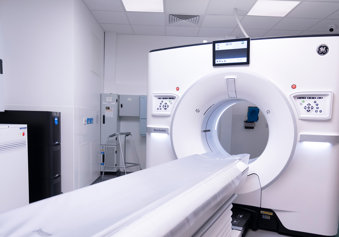Breast clinicians
Aims
- To recognise and standardise the training of breast clinicians.
- To increase the breast clinician workforce to support breast screening and symptomatic services.
The credential has been implemented through a pilot programme which began in 2019 with the first cohort of 10 trainees in England, supported by HEE which provided funding of £30,000 per trainee per year for the three years of the credential programme.
The credential curriculum is based around a number of high-level capabilities in practice. This is what a breast clinician will be expected to be able to do upon completion of the training. It includes considerable overlap with the breast content of the clinical radiology curriculum as well as covering clinical examination, risk factors such as family history and genetics, and the understanding of the use of prognostic and biological factors that influence oncological treatments.
Trainees will be required to pass the physics module of the First FRCR Examination in their first year of training. Assessment is workplace-based and formative in nature, leading to an annual review and summative assessment to confirm progress. Full details of the assessment programme are included in the curriculum. Trainee breast clinicians will be given access to our trainee e-portfolio, Kaizen, to document progress. Kaizen user guides are available for trainees and for supervisors.
The three-year training programme detailed in the curriculum covers multiple elements of training. The first year focuses on clinical skills, family history, and physics teaching in order to pass the FRCR examination.
The clinical and family history skills are built on during the second year, whilst now incorporating imaging interpretation and reporting, in a highly supervised capacity.
During the final year, increasing independence is expected in ultrasound and mammography work in addition to interventional procedures such as biopsy and localisation. Trainees will be employed by the breast screening units which will largely lead the training, but they will also be linked to the local radiology training programme to access relevant training and physics teaching.
Closely based on the Annual Review of Competence Progression (ARCP) process for specialty training, the review of credential trainees will be carried out by a national panel, convened by the Credential Project Board. A national review panel will ensure that a consistent standard is applied to all trainees across all training sites in this small pilot programme. It will be wholly independent of any of the pilot sites, thereby ensuring impartiality and avoiding decisions on progression being made by the same people responsible for the training of any individual trainee. The 'Process for the review of trainee performance and progression' gives full details of the process and the panel.
Health Education England has produced a suite of resources providing guidance on "Enhancing Supervision for Postgraduate Doctors in Training”.
Some useful documents:
Credential In Breast Disease Management For Breast Clinicians Guidance For Pilot Training Sites
Handbook: Enhancing Supervision For Postgraduate Doctors In Training
A Benchmarking Document For Trusts To Help Them To Assess Whether They Are Providing Good Supervision Standards In Supervision
Want to know more?
Head to our breast clinicians credential FAQ page to find the answers to some commonly-asked questions.
Clinical radiology
We’re here to support you throughout your career in clinical radiology – offering innovative training and promoting the specialty so that you have the resources you need to deliver better patient care.
